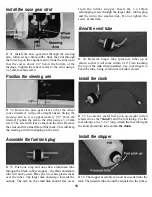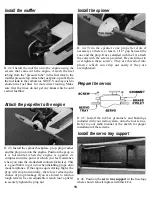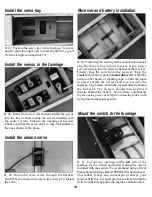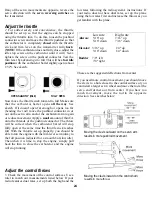
Charge the batteries
Follow the battery charging procedures in your radio
instruction manual. You should always charge your
transmitter and receiver batteries the night before you
go flying and at other times as recommended by the
radio manufacturer.
Balance the propeller
Balance your propellers carefully before flying. An
unbalanced prop is the single most significant cause of
damaging vibration. Not only will engine mounting
screws and bolts vibrate out, possibly with disastrous
effect, but vibration will also damage your radio
receiver and battery. Vibration will cause your fuel to
foam, which will, in turn, cause your engine to run
rough or quit.
We use a Top Flite Precision Magnetic Prop Balancer
(#TOPQ5700) in the workshop and keep a Great Planes
Fingertip Balancer (#GPMQ5000) in our flight box.
Find a safe place to fly
1. The best place to fly your R / C model is an AMA
(Academy of Model Aeronautics) chartered club field.
Ask your hobby shop dealer if there is such a club in your
area and join. Club fields are set up for R/C flying, which
makes your outing safer and more enjoyable. The AMA
can also tell you the name of a club in your area. We
recommend that you join the AMA and a local club so
you can have a safe place to fly and also have insurance
to cover you in case of a flying accident. (The AMA
address is listed on page 5 of this instruction book).
If there is not a flying club in your area, you need to find
a large open area, free of obstructions, with a smooth
surface that can be used as a runway. It should be
located at least 6 miles away from any other R / C
airplane operation and away from houses, buildings and
streets. A schoolyard may look inviting but it is too close
to people, power lines and possible radio interference.
Ground check the model
If you are not thoroughly familiar with the operation of
R/C models, ask an experienced modeler to check to
see that you have the radio installed correctly and that
all the control surfaces do what they are supposed to.
The engine operation must also be checked and the
engine "broken in." Follow the engine manufacturer's
recommendations for break in. Check to make sure all
screws remain tight, that the hinges are secure and that
the prop is on tight.
Range check your radio
Check the operation of the radio every time you fly.
This means that with the transmitter antenna
collapsed and the receiver and transmitter on, you
should be able to walk at least 100 feet away from the
model and still have control. Have someone help you.
Have them stand by your model and, while you work
the controls, tell you what the various control surfaces
are doing. Repeat this test with the engine running at
various speeds while an assistant holds the model. If
the control surfaces do not act correctly at all times, do
not fly! Find and correct the problem first.
Engine safety precautions
NOTE: Failure to follow these safety precautions may
result in severe injury to yourself and others.
Keep all engine fuel in a safe place, away from high
heat, sparks or flames, as fuel is very flammable. Do
not smoke near the engine or fuel; remember that the
engine exhaust gives off a great deal of deadly carbon
monoxide. Therefore do not run the engine in a closed
room or garage.
Get help from an experienced pilot when learning to
operate engines.
Use safety glasses when starting or running engines.
Do not run the engine in an area of loose gravel or
sand, as the propeller may throw such material in your
face or eyes.
Keep your face and body as well as all spectators away
from the plane of rotation of the propeller as you start
and run the engine.
Keep items such as these away from the prop: loose
clothing, shirt sleeves, ties, scarfs, long hair or loose
objects (pencils, screwdrivers) that may fall out of shirt
or jacket pockets into the prop.
26



































